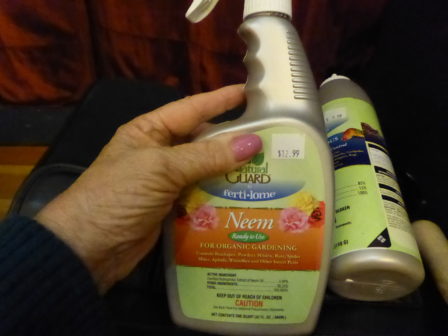Enriching Your Garden and Discouraging Bugs
A More Effective and Economical Source of Gardening Products

Organic gardening chemicals are available at Mission Hills Nursery.
Andy Danenberger is part of the Voluntary Purchasing Group (VPG). Their focus is on keeping a garden healthy without sacrificing the environment. He brought a host of products that, if used properly while carefully following the directions on the package, will help you to do just that. None of these products can be purchased at what he calls “big box” stores; only the privately owned nurseries that they have chosen as their dealers sell them. Andy said the company specializes in local problems and actually charges less than the large chain stores. Our Mission Hills Nursery is one distributor. In his presentation last February, Danenberger covered a variety of subjects, from pests to fertilizer.
One of our common pests in the coastal region is snails and slugs. They leave slimy trails behind them as they gnaw huge holes in our plants. His Natural Guard Ferti-lome Slug & Snail Bait is a good way to control them. He suggests sprinkling it around flowers, gardens, vegetables and fruit trees especially after a rain. It works best in moist areas and should be dampened to activate it. Early evening is the best time to use it as that is when these creatures dine. Danenberger says it should not be placed in piles. However, this product continues working even after a rain.
Another pest control they sell, RTU Caterpillar Killer Spray with Bt (Bacillus thuringiensis), controls worms and caterpillars (insects with alkaline guts). Since most insects and animals have acidic guts, this product does not harm them. Bt is living bacteria. However, if you are using it on slick surfaces (broccoli and cabbage, to name a few), you need Spreader Sticker to make the product adhere to the plant.
Diatomaceous Earth Crawling Insect Control is good for controlling cockroaches, ants, earwigs, crickets, bagworms, millipedes, fleas, carpet beetles, bedbugs, grasshoppers as well as slugs and snails. It is a natural product made from the bodies of microscopic fossils. It actually scratches the insects’ bodies, which causes them to dry out and die.
Spinosad is “the best worm and caterpillar control available.” It also works on many beetles and other chewing insects. It is said to be safe to use on edibles and can be used a day before harvesting most vegetables since it is a dead bacteria. It also is more effective with H//Y Spreader Sticker.
Spinosad Soap RTU (ready to use) is a better version of Potassium salts of fatty acids and Spinosad. It works on soft-bodies insects: mealybugs, fruit flies, and whiteflies as well as works, caterpillars, thrips, and small beetles. It also can control ants, psyllids, scale, earwigs, and mites. It may be used on vegetables, fruits, berries, herbs and ornamentals. Do not use it if the temperature is over 90 degrees
Neem insecticide is made from clarified hydrophobic extract, miticide, and fungicide killing eggs, larvae, and adult insects as well as spider mites, aphids, scale as well as powdery mildew, rust, black spot and more. It can be used on vegetables and fruits and ornamentals.
Another fairly safe insecticide is Natural Guard Insecticidal Soap with 47 percent potassium salts of fatty acids.
It is an insecticide for control of “soft-bodied” insects—aphids, lacebugs, mealybugs, leafhoppers, psyllids and whiteflies. To be effective, it must have contact with the insect; it leaves no residual. You may harvest it the same day you use it but only spray in early morning, evening or when overcast or foggy, never in full sun. As with any product, read the label, but this one should not be used on sensitive plants.
Another ready to use product is Copper Soap Fungicide. It works on plant bacteria only and is also a fungicide.
It can be used as a dormant spray for peach leaf curly, for early and late blight on tomatoes, for downy mildew, powdery mildew, leaf spot and many rot issues. It may be used on vegetables, fruits, ornamentals and turf. Avoid watering for 12 hours after applying, and re-apply it every five to 10 days.
After dealing with pests, Danenberger moved on to soil enrichments. One of his products is HuMic Granular Humates. It comes in a small size for raised beds, container gardens, small beds, houseplants, and compost bins among others. It helps revive last year’s potting soil so new plants become established more quickly. It should be applied every three to four months to the surface of the garden. Then work it into the top two to four inches of soil. Four pounds covers 500 square feet. The larger size is good to use on lawns and vegetable gardens. Apply it around established plants or mix it into the soil before planting seeds or transplanting. This helps control thatch, protects plants from low temperatures, and helps them retain water.
Danenberger told us about several other products; each works “if used as directed.” One that I am eager to try is Lawn Shield Insect Repellent. It makes an invisible cedar fence (an irritant) that keeps insects away and works instantly. You may use it in your gardens, patios, home perimeter, and lawns. Could it replace screens? The area may be used immediately after application when applied as directed. Let’s have a bug-free picnic!
Our next Mission Hills Garden Club meeting is Wednesday, September 27.
Category: Other







